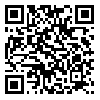Volume 13, Issue 2 (Vol.13, No.2, Summer 2017)
irje 2017, 13(2): 110-118 |
Back to browse issues page
Download citation:
BibTeX | RIS | EndNote | Medlars | ProCite | Reference Manager | RefWorks
Send citation to:



BibTeX | RIS | EndNote | Medlars | ProCite | Reference Manager | RefWorks
Send citation to:
Nejatifar M, Soori H, Ghaffari M. Validation of the Persian Version of the Injury Behavior Checklist (IBC). irje 2017; 13 (2) :110-118
URL: http://irje.tums.ac.ir/article-1-5756-en.html
URL: http://irje.tums.ac.ir/article-1-5756-en.html
1- MSc of Epidemiology, School of Public Health, Shahid Beheshti University of Medical Sciences, Tehran, Iran
2- Professor of Epidemiology, Safety Promotion and Injury Prevention Research Center, School of Public Health, Shahid Beheshti University of Medical Sciences, Tehran, Iran
3- Associate Professor of Public Health, Environmental and Occupational Hazard Control Research Center, School of Public Health, Shahid Beheshti University of Medical Sciences, Tehran, Iran
2- Professor of Epidemiology, Safety Promotion and Injury Prevention Research Center, School of Public Health, Shahid Beheshti University of Medical Sciences, Tehran, Iran
3- Associate Professor of Public Health, Environmental and Occupational Hazard Control Research Center, School of Public Health, Shahid Beheshti University of Medical Sciences, Tehran, Iran
Abstract: (7212 Views)
Background and Objectives: A feasible and cost-effective tool is required to investigate young children' behaviors with regard to the risk of injury. The aim of this study was to assess the psychometrics of the Persian version of the Injury Behavior Checklist (IBC).
Methods: After validating the translation (backward-forward translation), the final version of the checklist was developed through content analysis and face validity and according to the comments of a panel of experts. The final version was distributed among 300 mothers of children aged 2-5 years referring to the kindergartens of Tehran. Convergent validity was evaluated by internal consistency through calculation of Cronbach's alpha coefficient, as well as item-total correlation. The reliability of the checklist was assessed through the test-retest method with participating 55 mothers and comparison of the scores of the two steps by correlation coefficient and interclass correlation coefficient (ICC).
Results: The content validity ratio was acceptable (0.6-1) for 100% of the items, and the content validity index was 0.93 for relevancy and clarity and 0.92 for simplicity. The Cronbach's alpha coefficient was 0.87. All 24 items of the IBC were acceptably and directly correlated with the total score of the tool (r=0.25-0.65). Reliability results also confirmed the test-retest reliability of the Persian version of the IBC (r=0.90; ICC=0.86).
Conclusion: The Persian version of the IBC is a reliable tool for investigation of risk taking and its association with different injuries in children aged 2-5 years.
Methods: After validating the translation (backward-forward translation), the final version of the checklist was developed through content analysis and face validity and according to the comments of a panel of experts. The final version was distributed among 300 mothers of children aged 2-5 years referring to the kindergartens of Tehran. Convergent validity was evaluated by internal consistency through calculation of Cronbach's alpha coefficient, as well as item-total correlation. The reliability of the checklist was assessed through the test-retest method with participating 55 mothers and comparison of the scores of the two steps by correlation coefficient and interclass correlation coefficient (ICC).
Results: The content validity ratio was acceptable (0.6-1) for 100% of the items, and the content validity index was 0.93 for relevancy and clarity and 0.92 for simplicity. The Cronbach's alpha coefficient was 0.87. All 24 items of the IBC were acceptably and directly correlated with the total score of the tool (r=0.25-0.65). Reliability results also confirmed the test-retest reliability of the Persian version of the IBC (r=0.90; ICC=0.86).
Conclusion: The Persian version of the IBC is a reliable tool for investigation of risk taking and its association with different injuries in children aged 2-5 years.
Type of Study: Research |
Subject:
General
Received: 2017/08/29 | Accepted: 2017/08/29 | Published: 2017/08/29
Received: 2017/08/29 | Accepted: 2017/08/29 | Published: 2017/08/29
| Rights and permissions | |
 |
This work is licensed under a Creative Commons Attribution-NonCommercial 4.0 International License. |





